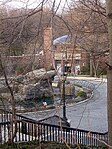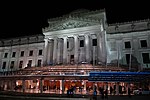The Battle of Long Island, also known as the Battle of Brooklyn and the Battle of Brooklyn Heights, was an action of the American Revolutionary War fought on Tuesday, August 27, 1776, at the western edge of Long Island in the present-day Brooklyn, New York. The British defeated the Americans and gained access to the strategically important Port of New York, which they held for the rest of the war. It was the first major battle to take place after the United States declared its independence on July 4, and in troop deployment and combat, it was the largest battle of the war.
After defeating the British in the siege of Boston on March 17, commander-in-chief George Washington relocated the Continental Army to defend the port city of New York, located at the southern end of Manhattan Island. Washington understood that the city's harbor would provide an excellent base for the Royal Navy, so he established defenses there and waited for the British to attack. In July, the British, under the command of General William Howe, landed a few miles across the harbor on the sparsely populated Staten Island, where they were reinforced by a fleet of ships in Lower New York Bay over the next month and a half, bringing their total force to 32,000 troops. Washington knew the difficulty in holding the city with the British fleet in control of the entrance to the harbor at the Narrows, and accordingly moved the bulk of his forces to Manhattan, believing that it would be the first target.
On August 21, the British landed on the shores of Gravesend Bay in southwest Kings County, across the Narrows from Staten Island and more than a dozen miles south of the established East River crossings to Manhattan. After five days of waiting, the British attacked the American defenses on the Guan Heights. Unknown to the Americans, however, Howe had brought his main army around their rear and attacked their flank soon after. The Americans panicked, resulting in twenty percent losses through casualties and capture, although a stand by 400 Maryland and Delaware troops prevented greater losses. The remainder of the army retreated to the main defenses on Brooklyn Heights. The British dug in for a siege, but on the night of August 29–30, Washington evacuated the entire army to Manhattan without the loss of supplies or a single life. The Continental Army was driven out of New York entirely after several more defeats and was forced to retreat through New Jersey to Pennsylvania.








